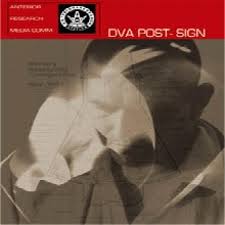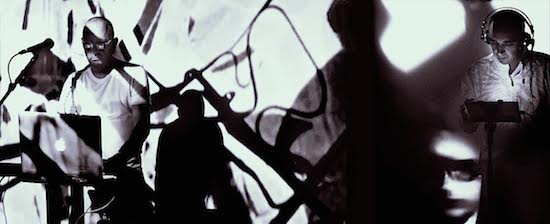Ah Adi Newton, what to think of you? In some ways Newton is the most contradictory of artists. Through over thirty five years’ work in The Future, Human League, Clock DVA and The Anti-Group he has made some joyously simple, affirmative and forward thinking music that nevertheless seems to trigger endless discussion and reinterpretation. Seen but not seen, simple and direct in sound and deed; but yet impossible to pin down. And as such his work – from the outside – can seem to be the preserve of some secret society; some weird Rotary club staffed by ghostly Satan-worshipping monks in Algernon Blackwood’s Secret Worship. All this mystery is, of course, the stuff that legends are built on but in other respects it’s a crying shame, as one of the first things to note about Adi Newton’s work with Clock DVA and The Anti-Group is its clarity and beauty. Yes, it can also present passages that are gnomic, puzzling and obtuse; all those things for sure, but then, Newton’s discipline of choice, industrial music, has often shrugged off such categorisations as "challenging" or "pioneering" or "difficult"; whilst busying itself with more important matters of creation.
The pull of the new, the re-release of the old – Post-Sign (2013: Anterior Research)

I’d wager that most of Newton’s work has always been interested with the ideal of a beauty that building a "new" future, or beginning again is supposed to bring; and you can certainly hear this in Clock DVA’s two latest releases. The clean lines, blank vistas and simple forms associated with new starts are represented in the sharp, crisp and sometimes clinical essays in sound that make up Post-Sign and Clock 2. But, despite this use of discipline in form, Newton sees the future as something that is essentially romantic; Post-Sign in particular is chock-full of dreamy melodic sweeps that counterpoint the music’s sonic mainframe. Just listen to that magnificent twist half way through Sigma 7 the kind of synthesised flounce that Thighpaulsandra would have stuck on a Queen Elizabeth record. Elsewhere, Memories Of Kelvin [For Era] and Project Paper Clip chug along like a melody-filled Zeppelins released from their moorings, blaring out the shape of things to come over commuter land. This music represents the sensuousness of an imagined, future "other" expressed in music and in image; the radical manipulation of shapes that express new thoughts, spatial iconoclasms that can create new understanding. With this in mind, there’s something cheerful and ultimately romantic about the insistent bleeps and blurts that underpin tracks like The Adoptive Morphology begins, and The Silencing. And Newton’s interest with Malevich, as seen in the extensive booklet that accompanies the Post-Sign release, is a key here; Malevich is long dead, but his dramatic ideas regarding the use of colour and form are often seen by Newton as a kick starter for fresh enquiries, or reevaluations.*
Form over function and the trickster element – Clock 2 (2014: Anterior Research)

Then there’s the pull of a different kind of physicality with Clock DVA’s worldview; a tricksy-yet-serious dicking about with format and notions of time; something that B S Johnson chased with his novel Albert Angelo, where Johnson cut out segments in pages, inviting the reader to look forward into a plot yet to come. And the opening lines on Clock 2, the ones launching the opening track The Konstruktor, seem to be straightforward future-love on the band’s behalf, as well as a weirdly suitable, pop art summary of BSJ’s literary peeping tom-isms; "The future begins with a break from the past". Well, up to a point, Lord Copper. Without doubting Newton’s motives, there’s something very dry, very Northern about the band’s latest release that counter-balances any grand plan.
For one, Clock DVA’s future-past shock treatment is seen with Clock 2‘s packaging. I can’t help thinking that the metal case that cases the USB package has all sorts of Loki-like properties; housing all sorts of material (visuals, remixes and album proper), being a self-contained object that offers no explanation of use, and a high powered sonic tool that you can plug in and use virtually anywhere should you wish. Still; once all this riddling is put to one side and the choices are made as to what you want to see, or hear, we are able to revel in the brilliance and high romance of the band’s direct, but all embracing music. Clock 2 shares the vast soundscapes and fizzing, pulsating framework of Post-Sign, but also boasts an additional toughness and an attention to even less unnecessary detail. For someone obsessed with things that aren’t corporeal, altered states and out of body experiences, there is a raw physicality that informs this work. On tracks like the ghostly Kabaret 13 or Rayonist nothing is wasted, but everything seems to be full of some deep-drawn invigorating sap. And the remixes (from Atom TM, Frank Bretschneider and Scanner) seem to be able to draw on the same rich elixir; and as such are brilliant additions rather than a set of afterthoughts or add-ons. Scanner’s magnificent remix of The Rayonist known as Rayonist Refraction 2 is a gargantuan 20+ minute essay that sways between sound tracking some imaginary Cold War spy film and being the field recording of some vast dumping ground for old PCs. In fact these reworkings seem to turn Clock 2 on its head, acting out some sonic idea of Misrule to Newton’s opening declamation; questioning what went before, asking us whether the future is represented by these remixes or the work proper.
I sincerely hope that this review hasn’t confused you further.
*Recently, Newton looked to clarify the relationship between Post-Sign and Malevich’s work over email to me:
"What the Post-Sign recordings represent is the formalisation of the ideas at that time, they’re studies. Often the study contains elements that are absent from the final work […] it’s not that the elements are irrelevant or have lost their meaning, it’s a process and within that process, there are changes as that’s the nature of the development. In fact this can be seen clearly in Malevich, from his early figurative works to the ultimate minimal abstraction of the black square where everything is reduced; colour/form/technique is reduced to a total absolute of the framing, or conceptualisation.
"In this sense Post-Sign represents the basis, the elements that were to be developed further. But these elements still retain their central importance. Sometimes those elements are lost in the development as the work takes on a more sophisticated form. It’s interesting to note that the word sophistication means a) the process or result of change from the natural or simple to the knowledgeable or cultured; worldliness b) complexity, as in design or organisation c) impairment; disillusionment. So in many ways the studies contain something vital and intuitive that becomes submerged or altered in the final production. Post-Sign represents those elements in their most vital and intuitive stage. I guess that’s why I went back to look at Malevich and the whole Russian avant garde art of that time, as it was always an inspiration to my work, as well as that of my colleagues Tez Maurzio Martinucci and Panagiotis Tomaras, so by re-studying the past there is always a new perspective as one develops and learns and rediscovers new aspects and other connections."
<div class="fb-comments" data-href="http://thequietus.com/articles/16103-clock-dva-post-sign-clock-2-review” data-width="550">


